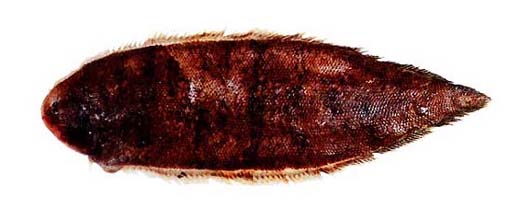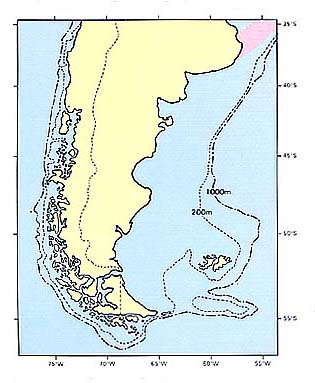ウシノシタ科
- HOME
- デジタル図鑑
- パタゴニア海域の重要水族
- 硬骨魚綱 カレイ目
- ウシノシタ科
ウシノシタ科(Cynoglossidae)

130 ミナミシマウシノシタ(Minami-shimaushinoshita)
Symphurus jenynsi Evermann et Kendall, 1907
Tapaculo(Arg., Urg.); Lenguita, Sol (Arg.); Lenguado-de-mulata (Br.)
特 徴:
背鰭108〜114鰭条,臀鰭92〜95鰭条,腹鰭4鰭条,尾鰭8〜10鰭条,体側中央の縦列鱗数118〜124。体長に対する体高の割合は26.9〜31.3%,頭長は17.4〜18.2%,眼径は1.3〜1.5%,吻長は3.7〜4.1%,上顎長は4.3〜4.7%(有眼側),3.7〜4.2%(無眼側),背鰭中央鰭条長は4.8〜4.9%,臀鰭中央鰭条長は5.2〜6.1%。体は長楕円形。吻の前縁は鈍く,その先端は下後方に曲がるが,上眼の前縁下に達しない。眼は非常に小さくて,上下眼は接近する。後鼻孔は両眼間隔域の直前にあり,鼻管を形成しない。口はゆるく曲って前方に開き,上顎の後端は下眼の中央下に達する。有眼側の下顎には歯がなく,上顎前部に4〜5本の小さな歯があるのみ。無眼側の歯は上顎上では円錐歯状でまばらに並び,下顎は絨毛状で小さな歯帯を形成する。口唇は発達していない。背鰭は上眼の上方の無眼側から発する。腹鰭は1個で正中線上にあるが,前方の鰭条は無眼側に倒れる。肛門は臀鰭第1鰭条のやや無眼側よりに開く。鱗は脱落しやすく,両体側とも強い櫛鱗。有眼側の側線はない。鰓耙はない。有眼側は茶褐色で,不明瞭な暗色横帯が体部に9〜10本みられる。背鰭,臀鰭の後部および尾鰭の鰭膜は黒味をおびる。背鰭,臀鰭に黒色斑はない。鰓蓋上にも黒斑はない。
分 布:
ブラジル南部からウルガイを経て,アルゼンチン北部まで。
備 考:
ブラジル南部に分布するS. plagusiaおよびS. diomedianus
は尾鰭鰭条数(12)および背鰭後部鰭膜上の黒斑の存在によって,本種と区別できる(Gutherz, 1978)。
(稲田伊史)
Material examined:
4 from Argentina (147.4-212.1 mm SL), FSFL EL 92, 93, 95, 97.
Description:
D 108-114; A 92-95; P24; C8-10; TRS 118-124.
HL 17.4-18.2% of SL; ED 1.3-1.5; BD 26.9-31.3; SN 3.7-4.1; UJ 4.3-4.7 (ocular side), 3.7-4.2 (blind side); DH 4.8-4.9; AH 5.2-6.1.
Body elongate and compressed. Snout tip blunt, curved posteroventrally, not reaching below anterior margin of upper jaw. Eye very small, both eyes closely situated. Posterior nostril without a tube and situated just in front of interorbital space. Mouth terminal slightly curved; posterior end of upper jaw reaching below middle of lower eye. Small conical teeth on upper jaw sparsely spaced in blind side, only 4 or 5 small teeth at anterior part in ocular side; teeth on lower jaw forming small villiform bands in blind side, edentate in ocular side. Lip without fringes. Dorsal fin beginning from upper part of upper eye in blind side. Pelvic fins asymmetrical and situated on midline; anterior rays of pelvic fin depressed in blind side. Anus situated just anterior to 1st ray of anal fin in blind side. Scales deciduous, strong ctenoid in both sides. No lateral line in ocular side. No gill-rakers. Color of ocular side light brownish, with 9 to 10 indistinct dark bands; posterior parts of dorsal and anal fin membranes blackish; no black blotches on dorsal and anal fins and opercle.
Distribution:
All the specimens were caught at the mouth of the Rio de La Plata in depths of 16 m.
Remarks:
These specimens differs from S. plagusia and S. diomedianus distributed in the southern Brazil by the characters of the number of caudal fin rays (12) and the presence of black of spots on the fin membranes of posterior dorsal and anal respectively (Gutherz, 1978). Another species S. jenysni is distributed of Uruguay and Argentina (Ringuelet and Aramburu, 1960), but it is not clear whether these are the same species or not.
(Tadashi INADA)

Distribution of Symphurus jenynsi in Patagonia.
- 1